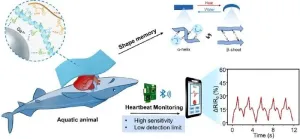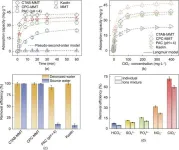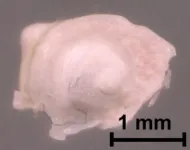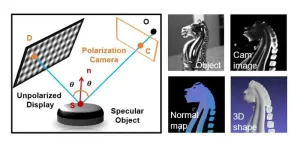(Press-News.org)
In a recent development published in Engineering, researchers have introduced a novel hybrid keratin (KE) hydrogel integrated with liquid metal (LM), offering new possibilities for monitoring the health of marine inhabitants. This innovation addresses the limitations of traditional wearable electronics in terms of biocompatibility, mechanical strength, and conductivity.
Monitoring the health and migration of marine organisms is crucial for maintaining the balance of marine ecosystems, advancing climate change studies, and safeguarding human health. However, developing sensors for marine organisms is challenging due to the complex marine environment and the unique characteristics of marine life. Existing hydrogel sensors often suffer from low conductivity, poor mechanical strength, and insufficient self-recovery capabilities.
To overcome these challenges, the research team combined KE, a protein abundant in feathers and wool, with eutectic gallium-indium (EGaIn) liquid metal. The KE provides biocompatibility, while the EGaIn enhances conductivity and mechanical properties. The resulting keratin liquid metal (KELM) hydrogel was prepared by dispersing LM in a 5% KE solution, followed by ultrasonication and polymerization.
The KELM hydrogel exhibits excellent mechanical properties, with a tensile strength of 166 kPa and a stretchability of 2600%. It also has a high conductivity of 6.84 S/m and a gauge factor (GF) of 7.03, making it highly sensitive to strain. The hydrogel’s adhesion strength on various substrates, including human skin and biological tissues, is remarkable, ensuring stable attachment for monitoring.
Biocompatibility tests on human epidermal keratinocyte (HACAT) cell lines demonstrated that the KELM hydrogel has minimal cytotoxicity and excellent cell compatibility. The hydrogel adhered well to human skin and aquatic animal skin without causing adverse reactions.
The KELM hydrogel-based wearable electronics were successfully used to monitor the heartbeats of invertebrate and vertebrate aquatic animals, such as scallops, sturgeons, and giant salamanders. The sensors can detect subtle changes in heartbeat patterns and transmit data wirelessly, providing valuable information for assessing the health of aquatic organisms.
While the current study shows great promise, the researchers acknowledge that for vertebrate aquatic animals, the invasive methods used for heartbeat monitoring may disrupt their physiological status. Future research will focus on developing minimally invasive installation techniques and improving the postoperative recovery environment. Additionally, multiple sensor arrays will be employed to achieve more precise behavioral monitoring.
This research on the KELM hydrogel not only provides a new approach for monitoring marine inhabitants’ health but also has potential applications in flexible electronics, medical monitoring, and wearable devices. It represents an important step forward in the development of biocompatible wearable sensors for diverse applications.
The paper “Biocompatible Protein/Liquid Metal Hydrogel-Enabled Wearable Electronics for Monitoring Marine Inhabitants’ Health,” authored by Lidong Wu, Jinxue Zhao, Yuanxin Li, Haiyang Qin, Xuejing Zhai, Peiyi Li, Yang Li, Yingnan Liu, Ningyue Chen, Yuan Li. Full text of the open access paper: https://doi.org/10.1016/j.eng.2024.12.030. For more information about the Engineering, follow us on X (https://twitter.com/EngineeringJrnl) & like us on Facebook (https://www.facebook.com/EngineeringJrnl).
END
To encourage scientists to speak up when people misuse science to serve political agendas, biology professor Mark Peifer of the University of North Carolina at Chapel Hill argues that eugenics should be included in college genetics curriculums. In an opinion paper publishing March 27 in the Cell Press journal Trends in Genetics, Peifer explains how he incorporated a discussion of eugenics into his molecular genetics course last year and why understanding the history of the field is critical for up-and-coming scientists.
“Eugenics is not dead but continues to influence science and policy today,” writes Peifer ...
About The Study: The results of this cohort study suggest that semaglutide use was associated with an increased risk of nonarteritic anterior ischemic optic neuropathy in patients with diabetes. However, the study’s retrospective design presents limitations, as it can only infer associations rather than establish causality; further studies are needed.
Corresponding Authors: To contact the corresponding authors, email Chun-Ju Lin, MD (doctoraga@gmail.com) and James Cheng-Chung ...
About The Study: Daily screen use was associated with later bedtimes and approximately 50 minutes less sleep each week in this study. Associations were greater among those with evening chronotypes, who are at risk for poor sleep due to social jetlag (i.e., misalignment between circadian rhythms and social commitments). These findings confirm disruptions to sleep from electronic screens are not limited to children and adolescents. Further work is needed to understand the best mechanisms for intervention.
Corresponding Author: To ...
About The Study: In this pooled cross-sectional study, findings suggest that state legislatures that elected to increase their state minimum wage may have also improved state food security rates among households with children at risk for economic hardship. The findings provide policymakers with actionable evidence to consider in setting minimum wages that could reduce the burden of food insecurity among U.S. children and families.
Corresponding Author: To contact the corresponding author, Megan R. Winkler, PhD, RN, email megan.winkler@emory.edu.
To ...
A study published in Engineering introduces an innovative approach to address the issue of perchlorate (ClO4−) contamination in water. Perchlorate is a harmful oxo-anion found in aquatic environments. It can enter the human body through drinking water and inhibit iodine absorption in the thyroid gland, potentially causing various thyroid-related diseases. Given the strict perchlorate limits in drinking water worldwide, such as 70 μg/L in China and 15 μg/L in the United States, developing efficient methods for its removal is crucial.
The research team, hailing from Hunan University and Shanghai Jiao Tong University, prepared an adsorbent ...
WASHINGTON — For the first time, researchers have shown that terahertz imaging can be used to visualize internal details of the mouse cochlea with micron-level spatial resolution. The non-invasive method could open new possibilities for diagnosing hearing loss and other ear-related conditions.
“Hearing relies on the cochlea, a spiral-shaped organ in the inner ear that converts sound waves into neural signals,” said research team leader Kazunori Serita from Waseda University in Japan. “Although conventional imaging methods often struggle to visualize this organ’s fine details, ...
(WASHINGTON—March 27, 2025) — A machine learning model generated by a team from the European Society for Blood and Marrow Transplantation (EBMT) outperformed standard statistical models in identifying and stratifying transplant risk for patients with myelofibrosis, according to new research published today in Blood, the American Society of Hematology’s flagship journal.
“Although there are many models available to identify patients with high-risk myelofibrosis, we are still lacking ...
Accurate and robust 3D imaging of specular, or mirror-like, surfaces is crucial in fields such as industrial inspection, medical imaging, virtual reality and cultural heritage preservation. Yet anyone who has visited a house of mirrors at an amusement park knows how difficult it is to judge the shape and distance of reflective objects.
This challenge also persists in science and engineering, where the accurate 3D imaging of specular surfaces has long been a focus in both optical metrology and computer vision research. While specialized techniques ...
Noted Maya archaeologist Julie Hoggarth, Ph.D., associate professor of anthropology at Baylor University, has been elected to the rank of AAAS Fellow, a lifetime honor announced today by the Council of the American Association for the Advancement of Science (AAAS), the world’s largest general scientific society and publisher of the Science family of journals.
Hoggarth is among the 471 scientists, engineers and innovators who have been elected 2024 Fellows for their scientifically and socially distinguished achievements throughout their careers. The new Fellow class hails from academic institutions, ...
DALLAS, March 27, 2025 — Recent analysis by the National Health Institute indicates that telehealth now accounts for 23% of all health care encounters nationwide, with some clinical specialties reporting virtual visit rates now exceeding 50%.[1] To help ensure quality care in this rapidly expanding field, the American Heart Association Center for Telehealth and the National Institutes of Health-funded University of North Carolina Chapel Hill Center for Virtual Care Value and Excellence (UNC-Chapel Hill ViVE), are building ...




